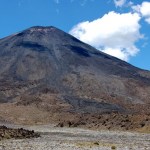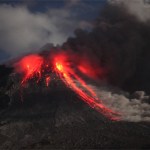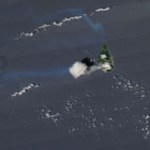Shiveluch
A new Weekly Volcanic Activity Report from the Smithsonian and USGS Global Volcanism Program!
Highlights from this week's report include:
Things are getting a little noisy in Colombia. I mentioned a few weeks ago about a possible explosion at Nevado del Ruiz. Now we have reports of increased seismicity under nearby Cerro MachÃn and ash plumes from Nevado del Huila. After a few centuries of relative quiet, it looks like the volcanoes of the Colombian Andes are looking more lively.
Also in South America, a gas plume was spotted at Chile's Planchon-Peteroa. This is the second time this year…
So, I'm a little late with this thanks to a little hiatus, but I thought I would post the latest GVP Weekly Volcanic Activity Report. Thanks again to the Smithsonian, USGS and especially Sally Kuhn Sennert!
Some highlights include:
There were more ash explosions spotted at Ebeko in Kamchatka, producing ~1.8 km (5,900 foot) ash columns. This activity prompted KVERT to raise the Alert Status to Yellow. This goes along with news from a pile of other Kamchatka/Kuril Island volcanoes: Gorely, Tiatia, Karymsky, Kliuchevskoi and Shiveluch.
More activity at Arenal in Costa Rica - its almost always…
Just a reminder, if you any questions for Sally Kuhn Sennert of the Smithsonian/USGS Global Volcanism Program - about the Weekly Report, about life at the GVP, about volcanoes - be sure to send them to me soon at .
Now, on to this week's update!
Some highlights (not including Gorely):
Lahars from Tungurahua in Ecuador moved blocks upwards of 2 m in diameter downstream over the last week and ash fall was reported over 20 km from the volcano's vent. For some reason, FoxNews decided to use an image of Tungurahua for an article on stats of natural disasters in 2009 - nice image, but the volcano…
News!
The summit crater lake at Gorely in Russia, taken on June 21, 2010. Image courtesy of KVERT.
Eruptions readers have been abuzz about how KVERT will be closing shop (yet again) at the end of June. This would, of course, leave no local monitoring and expertise in the very active Kamchatka Peninsula and Kuril Islands in Russia. Right now Shiveluch and Gorely are both showing signs of increased eruption (along with other volcanoes in the arc). In fact, Gorely, which hasn't erupted since 1986, looks primed to have an eruption, with increased tremors, steam-and-gas emissions and a new…
Africa is threatened by "scorching hot blobs of magma" according to the CSM.
Nothing like some fabulous headlines to make your day.
The first (courtesy of the Christian Science Monitor)
Massive blob of scorching magma discovered under southern Africa
Oh my! Yes, again, it seems that the many people in the media seem to be very confused about the nature of magma when it is underground - always expecting giant vats of swirling, molten magma rising up to destroy us all. Very few have a good sense of the real state of the Earth's mantle - mostly solid. The article is in fact about a recent study…
News for Monday!
Ngauruhoe in New Zealand, showing the dark lava flows of basaltic andesite on the slopes of the young volcanic cone. Image by Erik Klemetti, taken January 2009.
A couple pieces of news from two Russian volcanoes on the Kamchatka Peninsula: (1) last week's report of activity at Gorely appears to be semi-substantiated with new photos on the KVERT website (Russian). The images from June 6 and 12 (2010) shows steam plumes coming from the volcano - one as tall as 500 meters. Now, this doesn't imply that an eruption occurred, but it might suggest activity on on the upswing. KVERT…
Gaua erupting in February 2010. Image courtesy of the NASA Earth Observatory.
As a certain famous Icelandic native would say, "there is more to life than this."
Some other volcano news from around the world:
The situation at Gaua in Vanuatu is worsening. Ash from the current eruption is contaminating water and food supplies on the island. Authorities are planning on evacuating 3,000 people from the island if the eruption that started in 2009 gets worse, but there has already been significant ash fall, mudflows and explosions.
Shiveluch on the Kamchatka Peninsula in eastern Russia continues…
Actually, no the volcanoes aren't from space, but pictures of the volcanoes were taken from space. The NASA Earth Observatory has posted three more gems of volcanic activity taken by one of the fleet of earth imagers in orbit:
A recent image of Chaiten taken by EO-1. Image courtesy of the NASA Earth Observatory.
There is a great image of the busy Kamchatkan Peninsula, where four volcanoes are seen erupting in a single image - Kliuchevskoi, Bezymianny, Shiveluch and Karymsky. The plume from Karymsky is especially prominent as a grey streak above the white snow of the Russian winter (albeit…
Not a lot of big news, but a lot of little news:
Soufriere Hills at night during the late January 2010 dome growth episode. Note the hot rock falls from the collapsing dome. Image courtesy of Photovolcanica.
This might not be new, but Dr. Boris Behncke brought the new webcam at the rim of Chaiten in Chile to my attention. You get a birds-eye view of the growing dome from the edge of the caldera - pretty nifty view for a once-in-a-hundred-years sort of event.
The NASA Earth Observatory has posted a close-up of the Soufriere Hills imagethat I posted yesterday, showing the February 11 plume.…
Sally Sennert from the Smithsonian Institution sent me an email to say that this week's USGS/Smithsonian Institute Weekly Volcanic Report will be delayed due to the inclement weather in the Washington DC area. She can't connect with the server, so the report can't be updated on the Smithsonian website ... so here it is! Look for it to show up on the Smithsonian site with all the bells and whistles as soon as DC thaws out.
And a big thanks to Sally for sending me the Report to post.
***PLEASE NOTE: Website posting of the SI/USGS Weekly Volcanic Activity Report for 3-9 February 2010 will be…
Shiveluch in Kamchatka in an undated photo.
Just a quick note, but I got this email overnight regarding the status of KVERT, the Kamchatka-Kuril Island volcano monitoring body in Russia.
Scientists of KVERT Project return to the full KVERT operations (the
information ensuring of air services for the results of daily analysis
and evaluation of activity of Kamchatka and Northern Kuriles
volcanoes) and will discharge these obligations for 01 February - 30
April 2010.
So, after losing their funding, it has some back until the end of April (based on how I read this). Russian politics as usual?…
Bezymianny in Kamchatka, one of the many volcanoes in eastern Russia that will no longer be monitored by KVERT.
In some bad news for volcano watchers (and the general public, too), Russia has decided to stop funding KVERT (the Russian equivalent of the Alaska Volcano Observatory), the institute that monitors and researches volcanic eruptions on the Kamchatka Peninsula and the Kuril Islands in the western Pacific. Here is the news release from KVERT:
Due to a loss of government funding beginning February 01, 2010, KVERT will no longer
distribute information regarding volcanic activity in…
Here it is, my attempt to recap a year's worth of volcanic events. By no means is this supposed to capture every event, but rather the highlight/lowlights and what most captivated me during 2009. I'll be announcing the winner of the 2009 Pliny for Volcanic Event of the Year tomorrow.
Waimangu Geothermal Valley in New Zealand, taken in January 2009 by Erik Klemetti.
January
The year started out with a trip to New Zealand (well, for me at least) and vistas of the Waimangu Valley, formed in the 1886 eruption of Tarawera on the North Island. We were also still thinking about the late 2008…
The latest news from the USGS/Smithsonian Global Volcanism Program Weekly Volcano Report ...
Highlights (not including Mayon) include:
Strombolian eruptions and small pyroclastic falls at Arenal in Costa Rica.
3 km / 10 000 foot ash plume from Bagana on Bougainville Island in Papua New Guinea.
Rumbling noises, ~4.5 km / 14 000 foot ash plumes and incandescence were all reported coming from Fuego in Guatemala.
Steam-and-ash from Popocatepetl near Mexico City reached 7.4 km / 24 300 feet.
Satellite images of Shiveluch revealed a large thermal anomaly - the new lava dome - along with multiple…
I'll be giving a talk this afternoon here at Denison on rhyolite generation, so I might be a little brief this morning.
Undated image of Mayon in the Philippines.
The province of Albay in the Philippines is on alert for both a typhoon and a volcano (that country seems to be hit with that 300,000 may need to be ready to evacuate if the volcano continues to show signs that it might erupt - in fact, Mayon is producing ash as of this morning, albeit only one minor ash explosion.
Lava flows from Kilauea are drawing crowds as they inundate a road in Kalapana. There is a nice video link to the…
Before we get to the latest SI/USGS Weekly Volcanic Activity Report (WVAR), I wanted to draw your attention to some nifty NASA Earth Observatory images from the current activity at Soufriere Hills in Montserrat. After a few puffs last week, the volcano is now releasing a relatively constant stream of ash and steam, this after ~10 months of quiescence. The two images, one on October 12 and one on the 13th, suggest there is a lot of a variability, day to day, in the plume. See the latest WVAR for more info on Soufriere Hills.
On to the Report!
Highlights this week (not including Soufriere Hills…
Sometimes it is hard to keep up with the mountain of remote sensing (or not so remote) images that get released on the internet. Over the last few days, the NASA Earth Observatory has released a bunch of images/videos of current eruptions, so I thought I'd round them all up here for you to peruse.
Soufriere Hills releasing puffs of ash-and-steam on October 6, 2009. Image courtesy of the NASA Earth Observatory.
Four new images in the recent past:
A nice, clear picture of an ash-and-steam plume from Rabaul in PNG was captured by the Terra satellite's MODIS imager on September 30, 2009. The…
I missed the weekly report last week (sorry), but here is the new USGS/SI volcano activity report.
Highlights include:
Shiveluch in Kamchatka is still erupting away, producing ~7 km / 20,000 foot ash columns as the lava dome grows. There has also been pyroclastic flows spotted emanating from the new lava dome.
There was a report of a ~7.5 km / 25,000 foot ash-and-steam plume from El Reventador in Ecuador.
More small plumes and incandescent lava bombs were spotted at the Tavurvur Crater at Rabaul in Papau New Guinea
Monday is here again already ...
A pyroclastic flow from Soufriere Hills heading towards the ocean. Note the large volcaniclastic debris fan being formed by repeated flows. Dated March 2006.
The "Science Advisory Committee" at Montserrat in the West Indies suggests that the current eruption of Soufriere Hills on the small island could be drawing to a close. This is mostly based on the ever-decreasing seismicity under the volcano and that the volcano has not experienced any new dome growth or explosions over the last 6 months. Gas emissions have remained relatively constant over the last 18…
Undated photo of Shiveluch volcano in Russia.
In case you haven't seen the report yet, Shiveluch in Kamchatka has gone, as they say, "non-linear". KVERT has raised the alert level at the volcano to "Red" with reports of many strong explosions and an ash plume of >32,800 feet / >10 km. This all suggests that the volcano might have experienced [WARNING SPECULATION] a massive dome collapse followed by rapid decompression of the magma under the dome - causing the plinian eruption that seems to be underway. The size of this eruption plume will definitely have some effect on air travel over…


